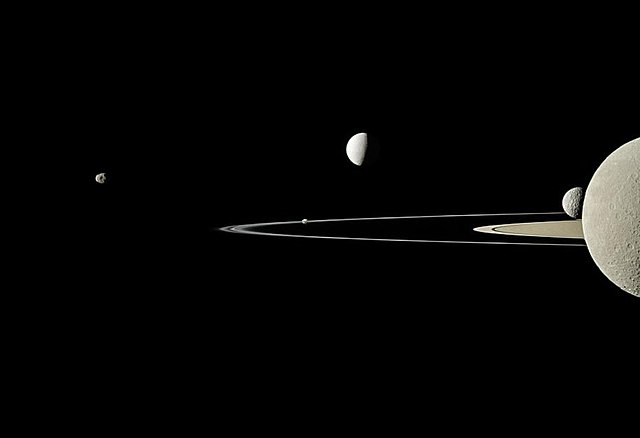Hyperion, also known as Saturn VII, is the eighth-largest moon of Saturn. It distinguished by its highly irregular shape, chaotic rotation, low density, and its unusual sponge-like appearance. It was the first non-rounded moon to be discovered.
Hyperion in approximately natural color, as photographed by the Cassini spacecraft. Bond-Lassell Dorsun arcs across much of Hyperion's face
William Cranch Bond, one of the discoverers of Hyperion
William Lassell, one of the discoverers of Hyperion
True-color image of Hyperion, taken by the Cassini spacecraft
The moons of Saturn are numerous and diverse, ranging from tiny moonlets only tens of meters across to the enormous Titan, which is larger than the planet Mercury. There are 146 moons with confirmed orbits, the most of any planet in the solar system. This number does not include the many thousands of moonlets embedded within Saturn's dense rings, nor hundreds of possible kilometer-sized distant moons that were seen through telescopes but not recaptured. Seven Saturnian moons are large enough to have collapsed into a relaxed, ellipsoidal shape, though only one or two of those, Titan and possibly Rhea, are currently in hydrostatic equilibrium. Three moons are particularly notable. Titan is the second-largest moon in the Solar System, with a nitrogen-rich Earth-like atmosphere and a landscape featuring river networks and hydrocarbon lakes. Enceladus emits jets of ice from its south-polar region and is covered in a deep layer of snow. Iapetus has contrasting black and white hemispheres as well as an extensive ridge of equatorial mountains among the tallest in the solar system.

An annotated picture of Saturn's many moons captured by the Cassini spacecraft. Shown in the image are Dione, Enceladus, Epimetheus, Prometheus, Mimas, Rhea, Janus, Tethys and Titan.
Saturn (overexposed) and the moons Iapetus, Titan, Dione, Hyperion, and Rhea viewed through a 12.5-inch telescope
Five moons in a Cassini image: Rhea bisected in the far-right foreground, Mimas behind it, bright Enceladus above and beyond the rings, Pandora eclipsed by the F Ring, and Janus off to the left
Quadruple Saturn–moon transit captured by the Hubble Space Telescope








